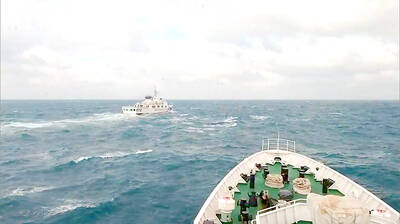Hundreds of protesters yesterday evening ended their 20-hour “occupation” of a government building in Taipei to protest against a land seizure in Miaoli County and land expropriation across the country, but vowed more occupation campaigns if the government failed to listen to their demands.
“As the protest draws to a close now, it is, at the same time, only a beginning. [The protest] serves as a warning to all government agencies, which betrayed their responsibility to the people, that they should be ready for people’s occupation at all times,” said Tsai Pei-hui (蔡培慧), spokesperson for the Taiwan Rural Front, the protest’s main organizer.
While the Ministry of the Interior’s (MOI) response to the protesters’ four demands was unacceptable, Tsai said a prolonged occupation would “fall into the government’s trap” because President Ma Ying-jeou’s (馬英九) administration was trying to wear the protesters out.

Photo: Chien Jung-fong, Taipei Times
The protesters chose to paralyze the operation of the ministry because it was in charge of land management affairs.
They demanded the MOI to apologize, compensate and return the lands to the four households in Dapu Borough (大埔) in Miaoli County’s Jhunan Township (竹南), whose houses were demolished on July 18, despite the government’s pledge to preserve them. They also asked the government to probe potential corruption cases related to land seizures and immediately amend the Land Expropriation Act (土地徵收條例).
Deputy Minister of the Interior Hsiao Chia-chi (蕭家淇) tried to break the deadlock with a meeting with the protesters at 11am yesterday, but failed to make substantial promises as he was whisked off by the crowds, who demanded to meet with Minister of the Interior Lee Hung-yuan (李鴻源).
Lee did not come out to meet with them, but organizers decided to call off the sit-in anyway, with Tsai saying the campaign was a relative success “because no one has ever besieged a government building and paralyzed a ministry before.”
The sit-in, part of the protest titled “818 Tear down the government,” was a follow-up to a night rally on Ketagalan Boulevard in front of the Presidential Office Building on Sunday evening. The rally, which organizers said drew about 20,000 participants, was held to commemorate the one-month anniversary of the demolition of the four houses, torn down to make way for a science park project.
The peaceful rally ended at about 10pm on Sunday, before the protesters caught the police by surprise as hundreds of demonstrators, who initially said they would stage an overnight sit-in in front of the Executive Yuan, executed a successful “ambush,” turning to the nearby Joint Central Government Building (JCGB) complex that also houses some of the legislative rooms.
After a brief confrontation with a thin police line, the crowds entered the complex and occupied both entrances of the South Tower of the JCGB, where they began the overnight sit-in without interruption from the police deployed in and around the building.
The protesters, consisting mostly of young people, raised a protest flag to replace the national flag in front of the building and sprayed slogans on the building walls and the pavement.
The police sent reinforcements yesterday morning, setting up blockades around the South Tower and monitoring pedestrians. Public servants were able to enter the North Tower and reach South Tower through an underground passage.
Supporters who could not make it to the sit-in tried to give the participants a lift by sending water, instant noodles and pizzas to the site.
Commenting on the protest, Legislative Speaker Wang Jin-pyng (王金平) criticized the demonstrators for removing a national flag and replacing it with a protest banner, calling the move “disrespectful, not just to the national flag, but also to the Legislative Yuan.”
The legislature respects the protest and appreciates their demands, but people should still respect the system and authority,” he said.
“What can they change by replacing a flag?” he added.
Additional reporting by CNA

Auckland rang in 2026 with a downtown fireworks display launched from New Zealand’s tallest structure, Sky Tower, making it the first major city to greet the new year at a celebration dampened by rain, while crowds in Taipei braved the elements to watch Taipei 101’s display. South Pacific countries are the first to bid farewell to 2025. Clocks struck midnight in Auckland, with a population of 1.7 million, 18 hours before the famous ball was to drop in New York’s Times Square. The five-minute display involved 3,500 fireworks launched from the 240m Sky Tower. Smaller community events were canceled across New Zealand’s

The Ministry of Foreign Affairs (MOFA) yesterday said it is closely monitoring developments in Venezuela, and would continue to cooperate with democratic allies and work together for regional and global security, stability, and prosperity. The remarks came after the US on Saturday launched a series of airstrikes in Venezuela and kidnapped Venezuelan President Nicolas Maduro, who was later flown to New York along with his wife. The pair face US charges related to drug trafficking and alleged cooperation with gangs designated as terrorist organizations. Maduro has denied the allegations. The ministry said that it is closely monitoring the political and economic situation

UNRELENTING: China attempted cyberattacks on Taiwan’s critical infrastructure 2.63 million times per day last year, up from 1.23 million in 2023, the NSB said China’s cyberarmy has long engaged in cyberattacks against Taiwan’s critical infrastructure, employing diverse and evolving tactics, the National Security Bureau (NSB) said yesterday, adding that cyberattacks on critical energy infrastructure last year increased 10-fold compared with the previous year. The NSB yesterday released a report titled Analysis on China’s Cyber Threats to Taiwan’s Critical Infrastructure in 2025, outlining the number of cyberattacks, major tactics and hacker groups. Taiwan’s national intelligence community identified a large number of cybersecurity incidents last year, the bureau said in a statement. China’s cyberarmy last year launched an average of 2.63 million intrusion attempts per day targeting Taiwan’s critical

‘SLICING METHOD’: In the event of a blockade, the China Coast Guard would intercept Taiwanese ships while its navy would seek to deter foreign intervention China’s military drills around Taiwan this week signaled potential strategies to cut the nation off from energy supplies and foreign military assistance, a US think tank report said. The Chinese People’s Liberation Army (PLA) conducted what it called “Justice Mission 2025” exercises from Monday to Tuesday in five maritime zones and airspace around Taiwan, calling them a warning to “Taiwanese independence” forces. In a report released on Wednesday, the Institute for the Study of War said the exercises effectively simulated blocking shipping routes to major port cities, including Kaohsiung, Keelung and Hualien. Taiwan would be highly vulnerable under such a blockade, because it